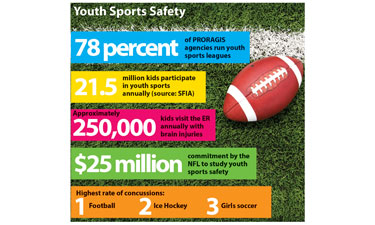 According to PRORAGIS, more than 78 percent of responding agencies managed youth sports leagues in 2013. This implies that park and recreation agencies are likely one of the largest facilitators of youth sports leagues in the country, and may only be rivaled by school-administered leagues when comparing numbers of participants.
According to PRORAGIS, more than 78 percent of responding agencies managed youth sports leagues in 2013. This implies that park and recreation agencies are likely one of the largest facilitators of youth sports leagues in the country, and may only be rivaled by school-administered leagues when comparing numbers of participants.
The positive impacts of sports on youth in our country can’t be overstated. As President Obama recently said at the White House Healthy Kids and Safe Sports Concussions Summit, they’re a part of our culture that provides important lessons for young people that enable future successes. However, it’s clear that the benefits of many sports are accompanied by risks that must be recognized and addressed to ensure we’re protecting kids as we’re teaching them through sports. As one of the largest providers of team sports opportunities for kids, park and recreation agencies must remain abreast of developments as they relate to sports safety.
One of the most concerning types of injuries that occur in youth sports is concussions. The May White House event brought together stakeholders to highlight the need for increased research and education regarding the best ways to prevent, diagnose and respond to concussions. While the long-term impacts of childhood concussions currently aren’t well understood, one thing is certain — concussions happen to at least 160,000 kids per year, and they don’t just happen in football. Kids who play basketball (~17,400), soccer (~13,500) and baseball (~6,700) also suffer concussions at concerning rates. In fact, these numbers almost certainly underestimate the actual prevalence of sports-related youth concussions, as they only factor emergency-room visits and not visits to urgent- or primary-care providers. According to the American College of Sports Medicine, at least 47 states have current or pending legislation regarding responsibilities of youth league management as it relates to concussion education, identification and clearance for return to play.
While we wait for research to fill the gaps in our knowledge, the best practice for park and recreation professionals is to apply what is known about concussions if yours is one of the almost four out of five agencies that manage youth sports leagues. Educate yourself and your staff using the variety of resources that currently exist. If a concussion is even suspected during the course of play or practice, remove the participant from play, and do not permit participation until evaluation and clearance from a healthcare provider trained in evaluation and management of concussions has been obtained. For many agencies, it may not only be the best way to protect the kids in your leagues, it may also be a legal responsibility.
Travis Smith, Ph.D., is NRPA’s Director of Research.

